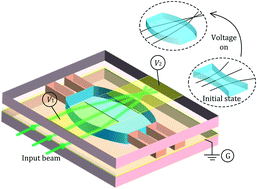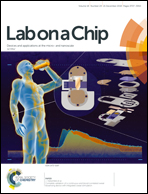Dielectrophoresis-actuated liquid lenses with dual air/liquid interfaces tuned from biconcave to biconvex†
Abstract
This paper reports an electrically reconfigurable optofluidic lens with two air–liquid (silicone oil) interfaces actuated by dielectrophoretic (DEP) force. Initially, a symmetric biconcave air–liquid lens is formed by the surface tension in a microfluidic chip. Then, the DEP force deforms the air–liquid interfaces from biconcave to biconvex, tuning the focal length from −0.5 mm to infinite to +0.5 mm. The wide tunability of the focal length results from the large refractive index difference (∼0.4 at the air–liquid interface), which is only 0.1 in previous liquid–liquid lenses. In the experiment, the lens achieves an ƒ number of 0.91 while consuming only 6.7 nJ per circle. Some asymmetric working states, such as concave–convex and plano-convex lenses, have also been demonstrated. Compared with continuous liquid flow-sustained lenses, this stationary liquid lens holds promise of better compatibility and higher scalability. Its wide tunability, low power consumption and easy operation make it suitable for light manipulation in microfluidic networks.



 Please wait while we load your content...
Please wait while we load your content...